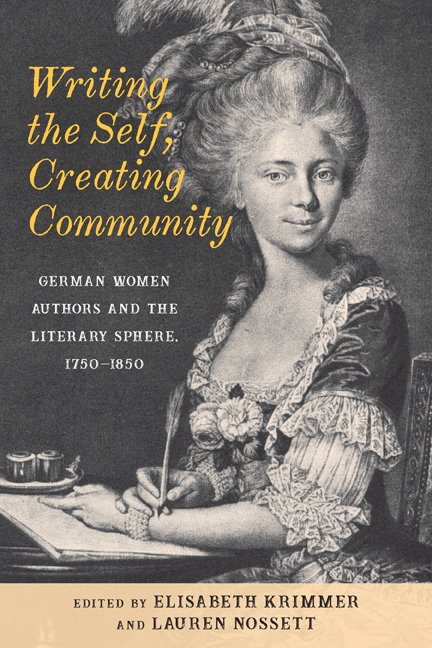Book contents
- Frontmatter
- Contents
- Acknowledgments
- Introduction
- Part I Writing a Community
- 1 Empowering Germany’s Daughters: On the Pedagogical Program and the Poetic Techniques of Sophie von La Roche
- 2 “Ich spreche lieber von guten Büchern”: Sophie von La Roche’s Concept of Female Authorship and Readership
- 3 Challenging Female Ideals: Marie-Elisabeth de La Fite’s Translation of Sophie von La Roche’s Geschichte des Fräuleins von Sternheim
- 4 Catherine II, Polyxene Büsching, and Johanna Charlotte Unzer: A Literary “Community of Practice”
- Part II Writing the Self
- 5 Ghostwriters: The Apparitional Author in Benedikte Naubert’s “Die Weiße Frau” (1792) and Sophie Albrecht’s Das Höfliche Gespenst (1797)
- 6 Vampirism Inverted: Pathology, Gender, and Authorship in Karoline von Günderrode’s “Die Bande der Liebe”
- 7 Wozu eine Amazonen—Literatur? Literary Creativity and Productivity in the Writings of Helmina von Chézy
- 8 Women Writers and the Märchenoma: Foremother, Identity, and Legacy
- Part III Writing toward Emancipation
- 9 The Illegitimacy of Authorship and the Legitimization of Passion in Agnes von Lilien
- 10 The Politics of the Female Body in Louise Aston’s and Fanny Lewald’s Writings through the Prism of the Romantic Theory of Sociability and Dialogue
- 11 Weibliche Irrsterne: Louise Otto and the Notion of Female Genius in Nineteenth-Century Germany
- Bibliography
- Notes on the Contributors
- Index
Introduction
Published online by Cambridge University Press: 01 October 2020
- Frontmatter
- Contents
- Acknowledgments
- Introduction
- Part I Writing a Community
- 1 Empowering Germany’s Daughters: On the Pedagogical Program and the Poetic Techniques of Sophie von La Roche
- 2 “Ich spreche lieber von guten Büchern”: Sophie von La Roche’s Concept of Female Authorship and Readership
- 3 Challenging Female Ideals: Marie-Elisabeth de La Fite’s Translation of Sophie von La Roche’s Geschichte des Fräuleins von Sternheim
- 4 Catherine II, Polyxene Büsching, and Johanna Charlotte Unzer: A Literary “Community of Practice”
- Part II Writing the Self
- 5 Ghostwriters: The Apparitional Author in Benedikte Naubert’s “Die Weiße Frau” (1792) and Sophie Albrecht’s Das Höfliche Gespenst (1797)
- 6 Vampirism Inverted: Pathology, Gender, and Authorship in Karoline von Günderrode’s “Die Bande der Liebe”
- 7 Wozu eine Amazonen—Literatur? Literary Creativity and Productivity in the Writings of Helmina von Chézy
- 8 Women Writers and the Märchenoma: Foremother, Identity, and Legacy
- Part III Writing toward Emancipation
- 9 The Illegitimacy of Authorship and the Legitimization of Passion in Agnes von Lilien
- 10 The Politics of the Female Body in Louise Aston’s and Fanny Lewald’s Writings through the Prism of the Romantic Theory of Sociability and Dialogue
- 11 Weibliche Irrsterne: Louise Otto and the Notion of Female Genius in Nineteenth-Century Germany
- Bibliography
- Notes on the Contributors
- Index
Summary
IN A LETTER TO CHARLOTTE SCHILLER (1766–1826) dated September 18, 1798, Charlotte von Stein (1742–1827) reports one of her dreams: “Im Traum sah ich ein dickes schön gedrucktes und gebundenes Buch, das ich allein geschrieben hatte … dies war ein guter Traum” (In a dream I saw a thick beautifully printed and bound book that I had written all by myself … this was a good dream). Von Stein's dream is quite remarkable. She projects a fantasy of artistic creation that emphasizes the finished and quasi-official nature of the imagined book: it is both printed and bound, and it is all her own. Buried in this dream is not only the yearning to become a writer but also the desire to participate in the literary marketplace and to be recognized publicly for one's creative work. In this, von Stein's dream speaks to both the possibilities that had opened up for women writers and the difficulties they still faced. Her letter to Charlotte Schiller is emblematic of both the female literary community women writers sought and their reflections on the process of writing. Aspirations such as those described in von Stein's dream, and the obstacles that stood in their way, form the subject of this book.
Building on important earlier research on German women writers of the eighteenth and nineteenth centuries, the articles in this volume are conceived as critical interventions in a reception history that tended to ignore women's works. We are interested in how German women writers around 1800 defined female authorship. In particular, we want to expand the scope of our investigation beyond the negative strategies employed by women writers of the time, such as hiding their intellectual accomplishments or legitimizing their works by subordinating them to nonartistic purposes. Instead, we ask how women wrote about their own creative process both directly (for example, by sketching a female poetology) and indirectly (for example, through literary representations of female authorship). What concepts of female authorship are presented in women's correspondence, theoretical statements, and literary works? How do female authors conceive of the relation between writing and the female body? Did women writers think of themselves as isolated practitioners or did they seek familial, social, or professional mentorship?
- Type
- Chapter
- Information
- Writing the Self, Creating CommunityGerman Women Authors and the Literary Sphere, 1750–1850, pp. 1 - 20Publisher: Boydell & BrewerPrint publication year: 2020

